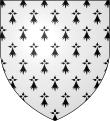Breton flag
The Breton flag , also called Gwenn-ha-du , that means something like white and black in Breton . It is also used in the Loire-Atlantique department , although this is no longer administratively part of Brittany . It was culturally and historically part of Brittany for a long time and is still part of Brittany in the self-image of long-established residents. Nantes (Naoned), its prefecture , was the capital of Brittany.
Not only cultural associations or the autonomists, but most of the Bretons feel they belong to the flag. In the past, the flag was only seen as the flag of the autonomists, now it is also used officially, e.g. B. on public buildings.
The opinion that is widespread among Bretons that the Breton flag is the only one that exists without colors, because it consists only of black and white elements, is wrong. The flags of the Swiss cantons of Freiburg and Basel-Stadt , the Spanish city of Ceuta or the English county of Cornwall are also made of black and white.
The flag was designed by Morvan Marchal (1900–1963, architect and member of various political organizations) in 1923. He was inspired by the coat of arms of the city of Rennes and the US flag.
The nine horizontal stripes represent the nine historic Breton provinces, the traditional duchies. The five black stripes symbolize the French and Gallo- speaking provinces of Dol , Nantes , Rennes , Saint-Malo and Saint-Brieuc . The four white stripes stand for the Breton-speaking provinces of Trégor , Léon , Cornouaille and Vannes . The 11 ermine tails are reminiscent of the coat of arms of the Duchy of Brittany.
The Breton flag was on public display for the first time in 1925 at the Exposition Internationale des Arts Décoratifs et industriels modern in Paris. It was used by various cultural and autonomous organizations in the 1920s and 1930s. Since 1960 one sees the "Gwenn ha du" more and more often. Today it is considered to be the Breton flag.
Rennes coat of arms
Coat of arms of Brittany above the city gate of Saint-Malo




